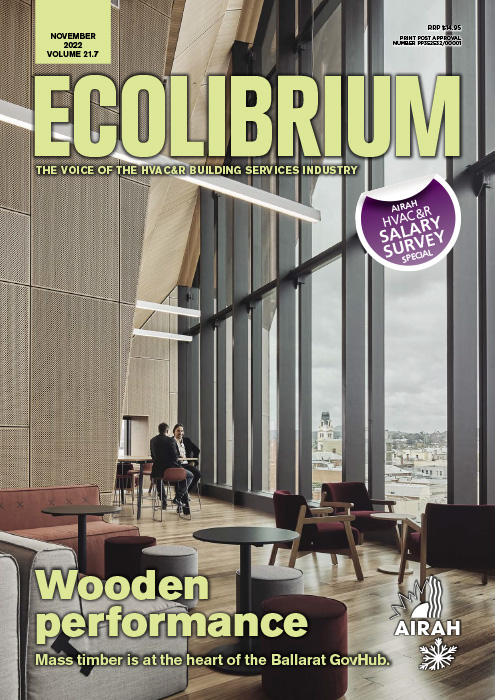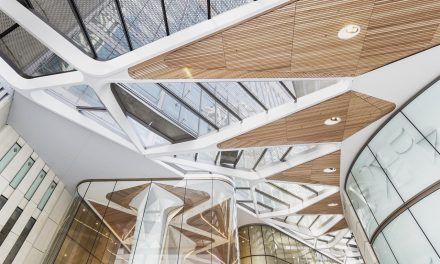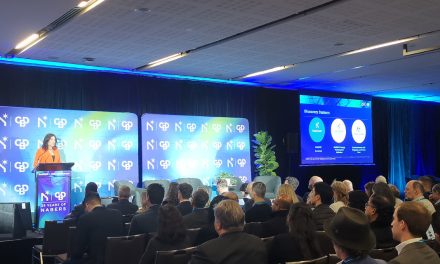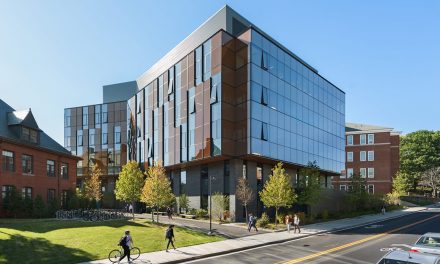Over the past decade the HVAC industry has experienced a maturity in fault- detection diagnostics. From a technical standpoint this has resulted in historical analytics, streaming analytics, forecasting, modelling, and a welter of other innovations changing the way to figure out what’s wrong with our buildings. Ideally this data can be used to radically change the way things are done, make BMS professionals more efficient, and actually generate some outcomes for facility owners and building owners.
The intent? Reduce the amount of time BMs professionals spend travelling unnecessarily to sites. And when site visits are necessary, ensure preparation is substantially improved.
Grosvenor Engineering Group’s Roshan Gill, M.AIRAH, hosts this roundtable discussion.
On the panel are Chris Stamatis, M.AIRAH, from CopperTree Analytics; Nicholas Lianos, Affil.AIRAH, from Grosvenor Engineering; Paul Dearlove from IBMS; and Anthony Guiragossian, M.AIRAH, from Johnson Controls.

Roshan Gill, M.AIRAH

Chris Stamatis , Affil.AIRAH

Nicholas Lianos, Affil.AIRAH

Paul Dearlove

Anthony Guiragossian, M.AIRAH
RG: Our first section covers, “What are the values and impediments to affecting augmented maintenance regimes or contracts?
So, Paul, what do you think to be the top two benefits of implementing data-driven maintenance and why?”
PD: Well, the first benefit is always if you consider the benefit is what the client perceives,
it’s got to be around value and performance. They want to see that they’re getting the maxim amount of value out of their maintenance contracts.
And that shouldn’t just be the most basic level of saving money but in terms of extending the life of their plant and equipment, getting the most efficiency out of that plant and equipment, so that they’re the overall value that’s delivered to the client. And it can vary from customer to customer. There’s no one simple answer to that one.
And then the second thing is, it’s a collaborative partnership obviously between the client and the service provider. And so, the service provider needs to make a dime. They’ve
got to make a buck on it otherwise what’s the point of doing it?
So how do you differentiate your service? How do you deliver service more effectively, particularly where, as with an earlier slide, which talked about labour shortages, and we know that’s a real key issue, and we’ve seen the skills in the industry decline over the years. So how do service providers maximise the quality and value of what they deliver with a declining workforce and declining skill base?
RG: Chris, what do you think the biggest impediment is to implementing these changes?
CS: Change itself. The industry has done maintenance a certain way for the last 20 years, 30 years, and now we’re saying you no longer perform these maintenance tasks and rely on a computer to analyse the data and drive maintenance activities onsite.
Changing the way people are doing things onsite is the biggest impediment. But that’s slowly changing, and people are really seeing the value and getting excited about the way these systems can streamline processes onsite.
“We should collect any data that we can do that makes financial sense right. But there’s a huge cost in a lot of these older assets in collecting that data”
RG: It sounds like there’s a strong human aspect that we can never get away from, right? We are the people on the ground doing the work, and people will never not be a part of this.
CS: Absolutely, and I don’t think we have a will to do that. We can’t remove people offsite. It’s as simple as, as good as analytics is, it’s never going to pick up that a pump’s leaking slightly and there’s a puddle of water in a plantroom. There are things that analytics can’t do, and we need to maintain people onsite, and continue using their judgment and technical expertise onsite as well.
AG: That’s an interesting point. I’ll just add something there. In order to make true digital transformation you need to have the technology platform, which as a market we are so advanced – we’ve got plenty of fantastic vendors that can do really fantastic things in terms of technology platforms, be that machine data or human-generated data.
But you also need the processes to change, and the people to understand that the change is important.
We’re all good at the technology part. But where investment and investment in time and resources in training needs to happen is in really helping people to understand that without setting up those processes there’s a there’s a massive impediment to the success of a restructured maintenance contract.
And without the right training for people and a change in mindset and an acceptance of the change, then we’re always going to be on the back foot. And as good as the technology can be, you really need to drive digital transformation across those three pillars.
RG: Are more clients asking for more data analytics across the service and industry?
NG: What clients are asking more of is energy savings, happy attendance, less
risk, higher NABERs ratings. Some clients believe that using technology could be a gateway to that, but everyone’s chasing those four outcomes.
What we just spoke about, everyone touched on it, the biggest impediment to change is change itself because we’re all human beings and we hate change.
The whole industry is on a flywheel going a thousand miles an hour, and we want it to go from reactive to proactive. I think it’s as simple as saying that we need to show our customers – landlords, tenants – that there’s going to be at least a 20 per cent energy saving and a 20 per cent saving in cost and energy to actually get the industry to listen and to want to adopt change.
Because unless there’s a financial element to this or an ESG outcome that is quantifiable, people aren’t going to go to that paradigm shift because it’s too hard to change. That’s the key: we’ve got to make deliver outcomes that are going to improve things by at least 20 per cent or more.
Because I don’t know about you, but I’ve been in meetings with customers, and if you say you’re going to achieve a 2 per cent energy saving and they’ve got to change something, what reaction do you think we get? Forget it, it’s all too hard.
But if you say we’re going to achieve a 25 per cent improvement, all of a sudden people listen. They might be willing to take it on, but it’s up to us to actually show them the path to doing that.
So, unless we actually guarantee really good big chunky outcomes, we aren’t going to see the change. It’s really up to us to do that. So, are our customers wanting more for less? Absolutely, but that’s never changed. It may have accentuated a bit more. COVID has put more pressure on things, and interest rates going up is certainly going to put more pressure on that.
“There are things that analytics can’t do, and we need to maintain people onsite”
RG: So, clients aren’t screaming for technology, they’re screaming for an outcome and that’s been seen by the type of KPIs that they impose on providers. Are there any odd or unique KPIs that are that have come in recent times?
PD: It’s an interesting question because quite often people lose sight of what the KPIs even are. We’re doing a project with a client at the moment, and they talked about even just business KPIs, and we were trying to give them a strategy plan around building that up. Instinctively they know what they should be but when they’re actually trying to
quantify them you say well how do you measure that now? They say, “Oh we don’t.” But they know it’s important, so even assisting customers with those KPIs can be really crucial.
I had a really interesting one as well, which was when we’re looking at how a client had a problem with the BMS service provider.
It was a contracted service provider providing a public/private partnership to the
government. And when we actually looked through their KPI set, and it was a massive set of KPIs that had been created. One of the biggest ones was actually sewers and sump pumps, which had the biggest commercial impact on their business, and they weren’t focusing on that at all. When we raised that with them and said, “So you’ve got this KPI that’s going to hit you with a big penalty”, they said, “Oh yeah, we get hit with that all the time.”
But there was no monitoring of it, no detection of it.
We explained that if we spent a bit of money and added it to their BMS, it would help.
“That would be fantastic,” they said.
And then then you get the light-bulb moment.
NL: You always like to learn from others, right, so what’s been the one industry
that has seen a huge paradigm shift over the last 10 years? I would say data centres. Everyone’s in the cloud now. Fifteen years ago, everyone had their own data centre. AWS has the biggest market share in cloud-based data centres. Why did that come about? Because they were smart enough to collapse the cost of cloud-based data centre hosting to such an extent that no one could see any financial value in having their own.
So, all of a sudden that whole industry changed globally. That gives you a good insight as to what we need to do as an industry if we want to see widescale adoption of analytics and all the rest of it.
RG: So as an industry we need to produce such a good service that the clients don’t want to attempt to do any portion of it themselves – it’s perfect. It works: the building’s working, no one’s complaining …
“It’s not like it’s even expensive, it’s just a paradigm shift in our thinking that’s required”
Roshan: The next topic is what type of data should we be feeding into building analytics in order to effectively generate value to the stakeholders?
AG: “What’s really important is looking at the outcome that needs to be achieved, and that comes from collaborating with the facility managers, the building owners, and any other stakeholders that are interested in achieving something from that building. But then also the service providers. We’re talking about restructuring maintenance contracts, so the service provider also needs to have the right level of data in order to do what they need to do. But the data should never be an impediment to being able to do some true digital transformation. So, with the data that’s available you should be able to do something; however, data integrity is also very important – almost more important than the type of data.
The data needs to be trustworthy, reliable and not intermittent. It needs to be
something that genuine decisions can be made from, and that comes back as part of the maintenance contract. There needs to be a focus on building reliability and data integrity. So rather than maintaining controllers and checking sensors’ calibration, our focus should be: is the data flowing, and can we trust it as part of our maintenance?
What type of data is important? It just needs to be good high-quality data. What is available should be used, but adding new sensors shouldn’t be an impediment to digital transformation.
CS: I completely agree with that. We should collect any data that we can do that makes financial sense right. It’s great to have all this data on what type of chiller it is, and what size valve and what sort of actuator and that kind of stuff. But there’s a huge cost in a lot of these older assets in collecting that data.
Should that be an impediment in deploying analytics? I don’t think so. Collecting data on whether or not the actuator is open or closed is more important than knowing exactly what type of actuator it is.
Newer buildings are getting fairly good at having all this data available to us, and these BIMS and digital twins and all this this information. If we can collect all of that and feed it into analytics, then great. But a lot of these older assets don’t have that. So, if we can collect the data efficiently and easily, that’s the data we digest.
“As a country, in Australia we’re uniquely placed because our tradesmen don’t care about hierarchy, they just want to fix stuff “
RG: How should a service technician spend their time when beholden to multiple masters? They’ve got their boss the service manager, they’ve got the FM, they’ve got an analytics platform telling them what to do. Who do they listen to when they’ve got a finite number of hours onsite?
PD: Any person to be fulfilled in the role needs to have clear understanding of their role in the job description. And part of that is the service technician fronts the organisation.
It’s the moment of truth that all clients experience, when a very, very good service person can make or break the relationship. It’s a tough job, because you’re often being asked to deal with a problem, a complaint or an issue.
As long as they’re given clear direction and they’re aligned to what the business is doing, they know what their job is, that’s what they’ve got to focus on.
NL: I’m really keen to contribute to this one given that we employ a few hundred of them. You just need to ask yourself what are they passionate about? And there’s really one thing they’re passionate about: They just love fixing stuff. I’ll tell you what they’re not passionate about: going up to a healthy acid and going, “Oh it’s healthy. Oh gee.”
They hate that. They hate preventative maintenance. They’d love to do just-in-time maintenance. They’d love to go to a building and just fix things that are getting sick.
That’s it. They don’t care about the service manager. The one thing we’ve got to do is get out of their way and give them the ability to do that. And that’s where big data and analytics allows, because you can have the virtual tech that does the boring stuff – “Oh these are the assets that are getting sick, I think. Can you go and look at these sick assets?”
The answer: “No mate, you’re an idiot. That algorithm’s not working properly. That’s wrong. That’s what we got to do. We’ve just got to give them that ability to allow them to be creative and to fix things.
And if we do that, do you know how amazing that’s going to be? Because these tradesmen, they’re going to become incredible building doctors.
They’re going to put they’re going to get paid better, they’re going to put more food on the table for their families. I get very passionate about this because it’s the future of our industry. And as a country, in Australia we’re uniquely placed because our tradesmen don’t care about hierarchy, they just want to fix stuff.
If you give them the knowledge that they need and get out of their way, they’re going to surprise us. That’s the key for me in how we move forward. We can lead the world in this.
AG: In a perfect world where digital transformation has happened well and the contracts are set up in the right way, so the process is done well, the stakeholders within the building – the facility managers and building owners – are aligned with the restructured maintenance contracts and understand what needs to be delivered, and the data platform is also delivering good insights, there shouldn’t necessarily be a deviation in the path that the different stakeholders want to go.
The service technician executing a very good service contract should be able to have clear
line of sight of what needs to be done, and should have the support of all of the stakeholders: the organisation that is undertaking the service, the building itself speaking through the data, and then the building stakeholders. They should really all be driving in in the same direction.
In the real world there are obviously going to be impediments to that, challenges. I keep harping back to people/process/technology. But it might be the process – it might be the contract not set up right. It might be the people; it might be a new facility manager that’s come in and really wants you to go and check the sensor even though you can double-check it here, or do that tube clean because it’s been exactly 12 months.
The more we can push towards a unified understanding of data-driven maintenance is the best thing we can do. We need to spend more time doing and less time reviewing. The service technician should have a more unified voice across all of the stakeholders, and it should be everyone pulling in the same direction – so optimised service.
RG: Chris is there any chance that we’re collecting too much data?
CS: Absolutely! We’re getting so caught up in big data – which is great, and we need to innovate and push and collect more data to do more things, but we’re sprinting
before we’re walking in a certain sense.
If we collect core data to deliver data-driven maintenance, that’s very different to collecting data for full artificial intelligence or … autonomous buildings. I don’t think we need to go to that level to just deliver a data-driven maintenance contract. Not only is there additional cost in doing that and certain barriers, but yes there’s diminishing returns on collecting a lot of that data as well.
We need to deliver smart systems to allow our technicians onsite to deliver maintenance and fix things, and we know that better maintained buildings perform better – that’s pretty basic.
We get caught up in in collecting too much data a lot of the time, and not using that data effectively at the moment. It will come in in time right and we’re all innovating and pushing and doing these things, but right now a lot of it’s pie in the sky kind of stuff. We’re innovating, but we’re not effectively using it onsite.
“We’re getting so caught up in big data – which is great, and we need to innovate and push and collect more data to do more things, but we’re sprinting before we’re walking”
RG: So, if you have to choose a minimum data set that we would suggest to a client that doesn’t have any level of technology – let’s say they don’t even have a BMS for argument’s sake – what should we advise them to collect?
At a bare minimum, we say all IO on the system and all control points. At that level of data collection, we can perform basic checks and basic analytics on equipment to drive maintenance.
Yes, we need to know that that it’s an air-handling unit, but at the end of the day do we need to know that it’s an Air Change air-handling unit of model xyz? And yes, we need to know that it’s a chiller, but do we need to know that it’s a centrifuge chiller or a screw-type chiller to perform basic maintenance?
Once we start getting up into optimisation and really driving some kind of optimisation tasks onsite, yes, we need to know those things. But for basic maintenance I don’t think we need to know that.
NL: If you’re going to have analytics like machine data analytics, that’s certainly the starting point. But if you want to go back and strip it right back to the absolute minimum information you need – and you don’t have any analytics, there’s no technology – really there’s just a couple of key things.
One is how much of the cost is reactive versus proactive – don’t need any technology for that. The trunk roll is reactive because someone rang up and complained that something needs to be fixed.
So, you need to understand the difference between those two things and then the other thing you need to do when the tradesman goes to site it is to say, “This is the asset that I touched, and this was the source of the problem”. That’s it.
And if you’re wondering about the data set that I spoke about earlier across the 14,000 buildings that was just that data over 20 years. That’s it. That’s the absolute minimum we should be doing. But you’d be amazed at how many people when you tell them that, they go, “No, we don’t want to do that”.
I mean that’s the minimum we should be doing as an industry. Just collect that, and then you start laying on top of it. Virtual technicians come along, then you go to the minimum data sets that we’re talking about.
So, it’s not like it’s even expensive, it’s just a paradigm shift in our thinking that’s required.
PD: One of the most impressive people I’ve met was the engineering manager for Accor
Asia Pacific. He had that number – preventative versus reactive – for every Accor hotel in Asia Pacific in his head. And he could go into any hotel and tell you straight away what was wrong just by that one number: reactive versus preventative.
And I’ve seen that graph – the little ball graph – it’s where do you find that optimum point? That’s what he would always try to drive towards.
AG: It’s going to come back to what do you want to achieve? What is the outcome? Who needs to use the data? What are we looking for? And that’s going to be collaborative conversation, and most of the time the minimum data that you need will be available in some way shape or form.
If the question is, “What’s the minimum you need?” The next question has to be, “What are you trying to do with it?” And then you can answer that first question.
“Vertical transport drops into that one as well because of the obscurity of it, and the mystical nature that industry has created”
RG: What are the highlights of broaching changes in maintenance for services outside of HVAC? What’s the highest value service that you’d look at first cab of the rank besides HVAC if you wanted to have analytics on it?
NL: I would say fire safety systems. There are so many prescriptive maintenance tasks on fire because it’s such an incredibly important thin. But if you go through and analyse, say AS1851 and all the tasks are there. And you go and look at how many of them are labour-intensive, and you isolate what a fire panel does and what algorithms you could run.
You still need the people to go there, but can they collapse the amount of time they’re spending onsite because they’ve already done the analysis and it’s more a confirmation thing about what needs to be looked at?
Plumbing systems are becoming smarter and obviously BMS and HVAC are the easy ones. “But I would say look at all your labour-intensive maintenance practices in buildings in whatever technical disciplines, and that’s your answer.”
PD: Vertical transport drops into that one as well because of the obscurity of it, and the mystical nature that industry has created. A lot of clients will talk to us about, “Can you do something with the lifts?”
RG: Is legislation stopping that? Fire, electrical … a lot of them are very regular tasks that have to be done but sometimes automating those might be restricted by just standards.
PD: Emergency lighting was in that rank but then once they brought in the automated reporting solution. So, it changed. It goes back to … around trusting and the reliability of the data. It’s important that any automated system not only just provides the report but provides you a level of certainty that you can trust that data.
“We need to spend more time doing and less time reviewing”
RG: So, given the focus on data driven maintenance what does the future maintenance contract look like within the next five years?
AG: “We don’t need to look five years into the future. We have everything we need today to be able to deliver fantastic data-driven maintenance: really good maintenance contracts with really good outcomes. We’ve got the platforms. We’ve got a fantastic understanding
across many stakeholders that it’s important to use the data to drive the outcomes today.
We need to build the processes, and we need to have acceptance on the processes as well.
We don’t need to look too far to be able to do it.
And already we can see across a number of organisations … really good maintenance execution, really good maintenance contracts. You don’t need to look too far into the future; it’s happening today. It’s happening right now.
PD: I’m going to be a bit provocative and challenge our panel for this. Anthony’s mentioned the process piece, and that is a bit that is still a bit broken in delivering these outcomes.
One of the things we were doing was when we were starting to put these predictive-type maintenance contracts together, we offered what we called a service-level-agreement approach, and provided some oversight to that.
And the idea was it was to help transition it through and then it wouldn’t be needed anymore. But it ended up that we kept getting asked back by customers: “Do it for another 12 months; Do it for another 12 months!”
We were just running a meeting, putting some minutes out, putting action items that aren’t getting done. And that wasn’t just the service providers, it was the FM and client and everyone. That piece is still a bit broken. That process of people doing busy work or going back to doing what they’re doing rather than focusing on where the benefit is, is something that still needs to be fixed before we get to that next level of the nirvana of data-driven maintenance or predictive maintenance.
CS: Right now, with a lot of the platforms you look at, a lot of platforms out there and the way we’re using data and analytics to drive maintenance, it is quite technical. The platforms are very technical; they’re not simplified. They’re not easy for people to just pick up and use. And that’s what we need: we need platforms that are basic to use so we’re not dragging in people every month to say, “Oh how do I use this again?” or, “How do I do this?” “How do I perform maintenance?”
It just needs to be simple to use. Clear. So, people, a, actually want to use it but b, don’t just push to the side because it’s too hard.
NL: We’re just talking about “plug and play” – that’s what we all want. All I know is within the next 10 years all this will happen. We need to have a data asset ontology universal translator, but I see a world where virtual technicians are working alongside real technicians. I see a world where you win a maintenance contract, and you go, and you plug into the building and plug and play, and all of a sudden, your virtual technician is up and running.
I see the real technicians using the virtual tech for all the boring stuff so they can do the really exciting stuff. That’s the maintenance contract I see.
Certainly, the big property owners are understanding that, and they’re looking at how they can standardise that plug and play but we’re not there yet, and I certainly acknowledge that there are companies that have some of that technology. But it’s about how we do it across all the buildings – and you’ve got older buildings, and so on.
But there’s no question that in a future maintenance contract, virtual techs will work alongside real techs. Some property owners will have their own virtual techs in the building regardless of the service provider. But the service providers will bring their own, so all of a sudden you want the service provider to be collaborating with the virtual tech that the customer already has in his building to make sure that any actionable insights that virtual tech is finding can be corroborated by the real technician as well.
So, there’s got to be connectivity there: again, plug and play.
An asset ontology dictionary or translator – that’s a key element that we need, and we’ve got to work together on that.
Like to know more?
This roundtable discussion is an edited transcript from a session that took place at AIRAH’s 2022 Big Data Forum. To watch the entire session, view here.












